Articles
The Shingle Sawing Machine in British Columbia 1901 to 1925
The production and use of shingle machinery formed a significant aspect of British Columbia's early industrial development. The early shingle machines, designed and manufactured in the East, were drastically redesigned in British Columbia and then produced by local firms. The production of these new machines provided several British Columbia engineering firms, especially the Schaake Machine Works and Let-son and Burpee Limited, with a significant part of their revenue and thus with an opportunity for expansion and the development of additional products. A great deal of effort on the part of British Columbia's mechanics and engineers went into the continual redesign of the shingle sawing machine, probably as a result of increasing competition. Production of the new shingle machines gradually spread throughout the Pacific Northwest and then into the eastern United States. Frequently the technical change was not just the reworking of previously applied principles but rather involved the application of entirely new principles, new at least to shingle machinery. The introduction of these machines occurred at a time when the British Columbia shingle industry entered a period of tremendous growth. Due to the much higher quality of shingles produced by the new machines, the province's shingle manufacturers were able to penetrate and maintain a share of major markets in the eastern United States.
La production et l'utilisation de machines à fabriquer les bardeaux marquèrent les débuts de l'industrialisation en Colombie-Britannique. Les entreprises de cette province modifièrent radicalement le dessin des premières machines à bardeaux fabriqués dans l'Est avant d'en commencer la production. Plusieurs bureaux d'ingénieurs de Colombie-Britannique, en particulier les sociétés Schaake Machine Works et Letson and Burpee Limited, tiraient une importante part de leurs revenus de la fabrication de ces nouvelles machines et purent ainsi s'agrandir et mettre au point de nouveaux produits. Les techniciens et les ingénieurs, probablement sous la pression de la concurrence croissante, consacrèrent leurs efforts au perfectionnement continuel de la scie à bardeaux. La fabrication des nouvelles machines s'étendit peu à peu à la côte du Pacifique, puis à l'Est des Etats-Unis. L'amélioration technique était souvent plus qu'un simple remaniement de principes déjà appliqués et faisait plutôt intervenir des principes innovateurs, encore jamais appliqués à la fabrication du bardeau. Les machines firent leur apparition au moment où l'industrie du bardeau de la Colombie-Britrannique entrait dans une période de croissance accélérée. Grâce à la qualité très supérieure de leurs produits, les fabricants de la province firent une percée sur les grands marchés de l'Est des États- Unis et surent s'y maintenir.
1 The introduction and use of the "upright" shingle sawing machine was an event of significance to British Columbia's industrial development. The improved version, invented in British Columbia, became available to British Columbia mills at the time the province's shingle industry entered a period of rapid expansion. It was the availability of these upright machines that enabled the province's shingle mills to compete successfully with the longer-established shingle mills in the United States. The American shingle mills continued to depend upon the earlier developed horizontal sawing machines which produced more shingles per shift but produced shingles of a lower grade than those produced by the upright machines.1 British Columbia therefore quickly gained a reputation for high quality shingles, allowing the province's shingle mills to penetrate the major eastern American markets despite tariffs and generally higher production costs.
2 The rapid growth of the British Columbia shingle industry near the turn of the century provided the ideal climate for the development of an important secondary industry, that of manufacturing and supplying shingle machinery to the rapidly expanding mills. The industry was relatively small but proved to be both dynamic and important for the provincial economy. The initial improvements to the "Dunbar" upright shingle sawing machine were made in British Columbia and British Columbia engineers and mechanics continued to devote considerable effort to the steady improvement of the shingle sawing machine. Production of shingle machinery in British Columbia began in 1901 with a single firm, but by 1920 five companies had shingle machinery available and three of these were among the major industrial plants of the province.
3 The introduction of a new setworks by Letson and Burpee in 1925 marked the start of a decline in the rate of shingle machine improvement. In the years following 1925 minor improvements were made but generally these were a continuation of already established trends, including a widespread conversion of the machines from line shaft to individual electric motors and the complete elimination of wooden features.2
4 In order to understand the early developments in machinery, a brief summary of the shingle industry is necessary. In terms of the total value of all types of forest products, wood shingles were a comparatively minor segment. However, as a major North American roofing material, shingles formed a significant part of both the physical and economic landscape of Canada and the United States. The use of shingles extends back to early European history, while in North America they formed one of the earliest items of barter.3 Their influence even gave rise to the shingle style of architecture in the nineteenth century. It was only in the twentieth century that shingles came under serious attack and went into decline with the widespread use of cheap substitutes such as the asphalt shingle.
5 North American shingle production reached its peak and was declining by the time British Columbia became a major producer. The total production of shingles in British Columbia rose from 725 million per year in 1909 to nearly 2½ billion in 1919, but in the United States total shingle production declined from nearly 15 billion shingles in 1909 to about 9½ billion shingles in 1919.4 This difference can be accounted for by several factors. British Columbia's growth was a result of the late start of its shingle industry expansion and the magnificant stands of western red cedar that remained unused until a relatively late date. The decline in the United States was a result of the gradual depletion of American timber resources suitable for shingles and the introduction of cheap asphalt substitutes. Adverse advertising, which warned of the fire hazards associated with wooden shingles at the same time that cheap substitutes became available, greatly affected American production.
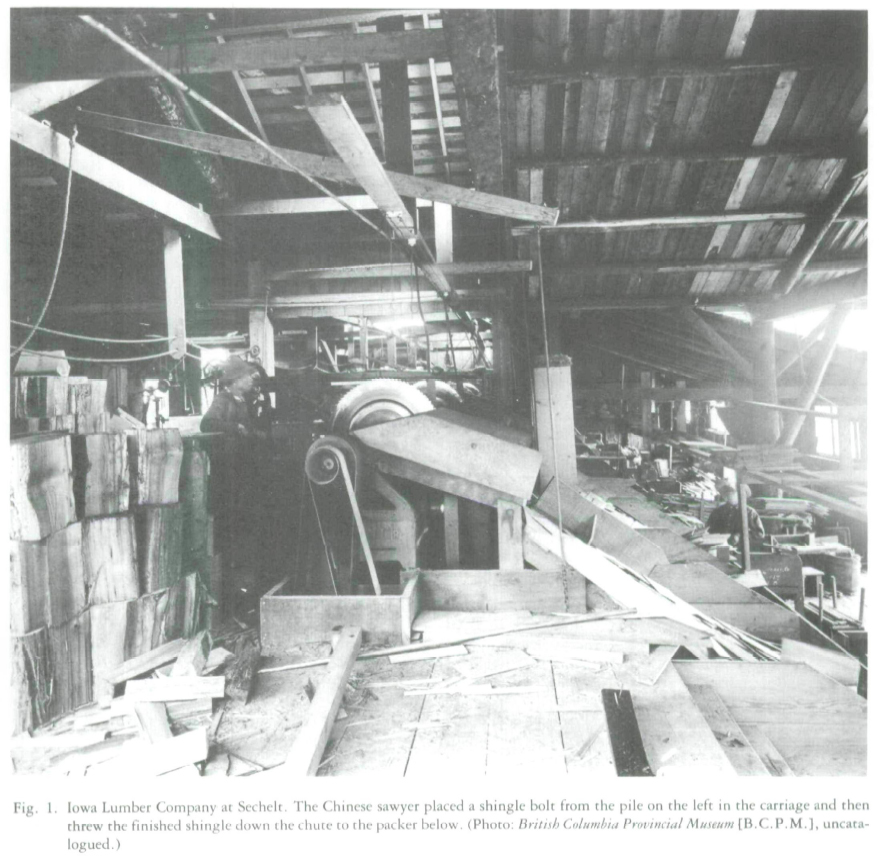 Display large image of Figure 1
Display large image of Figure 16 The cedar shingle was (and is) a small flat piece of wood approximately ⅞-inch thick, 16, 18, or 24 inches long, and with a width that varied with the size of block being cut and the grade of the shingle. Shingles have been made from a wide variety of tree species; the most suitable in eastern North America were found to be pine and white cedar, while in the southern United States southern white cedar and cypress were used. In the Pacific Northwest, western red cedar was considered ideal. The main characteristics desired in a wood for shingles are straight grain to aid splitting, durability, dimensional stability, light weight, and adequate strength. Western red cedar excelled in these characteristics and was considered to be slightly above any other species for the quality of its product.5 Red cedar gradually dominated shingle production so that by 1922, 79 per cent of all shingles cut in the United States were cedar and the bulk of these were red cedar followed by cypress with about 11 per cent of the cut. In British Columbia nearly all shingles were cut from red cedar.6
7 Shingle machinery was patented in the United States as early as 1802 and before 1825 shingle sawing machinery was available.7 Prior to the use of such machinery shingles were split by hand. (These are now called shakes.) By at least 1900 the standard procedure in the manufacture of shingles was along the following pattern. The log was first brought up into the mill and cut into rounds of the appropriate length; the rounds were then divided into triangular bolts. Alternatively, the bolts might be prepared prior to the wood reaching the shingle mill. The bolts were then fed to an individual machine or to a line of machines, and the operator at each machine placed a bolt into the carriage of the sawing machine. Once set into motion the carriage pushed the bolt past the saw, slicing off a shingle; then the carriage automatically returned for another slice, automatically advancing the bolt so that each shingle would be tapered. The operator picked up the shingles as they came off the saw and jointed them - that is, removed waste wood and squared the sides - on a second saw. He then tossed the finished shingles down separate chutes according to grade. At the foot of the chutes a shingle packer would bundle the shingles.8
8 The shingle industry in British Columbia grew slowly because it was simpler to export cedar logs to the mills in the United States than construct a mill in the comparatively unsettled province. British Columbia did not begin large-scale production of shingles until after 1901 at which time an amendment to the forest act prohibited the export of cedar logs. Prior to this most shingle production in the Pacific Northwest was carried out in Washington and Oregon. As early as 1845 and 1848 shingles were being produced on the Columbia River and Puget Sound for export. The Fraser River and Cariboo gold rushes brought with them a building boom, particularly in Victoria, and relatively large quantities of shingles were imported from Puget Sound. By 1865 shingles were also being forwarded to Victoria from Burrard Inlet. In 1870 two mills producing shingles on Burrard Inlet exported 256,000 shingles to China; by 1881 there were 5 mills producing shingles in British Columbia while by 1891 there were 9 mills. The completion of the Northern Pacific Railroad to Portland, Oregon, in 1883 and the construction of the Cascade Division in 1887 began to shift the centre of American shingle production from the southern states to the Pacific Northwest.9
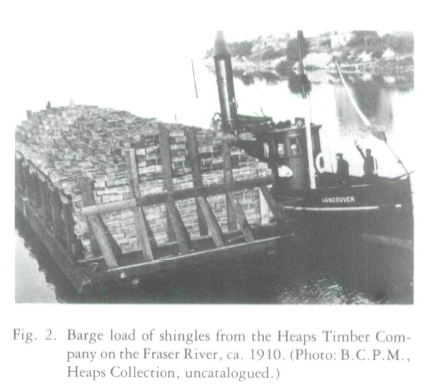 Display large image of Figure 2
Display large image of Figure 29 In 1889 there were 40 to 50 shingle mills in Washington and Oregon but by 1892, just prior to the completion of the Great Northern Railroad to Seattle, there were over 200 shingle mills in western Washington alone. The completion of the Canadian Pacific Railway in 1885 did not have the same effect on the British Columbia shingle industry for two reasons. In the first place it was relatively cheap to export logs to the existing American mills. In addition most shingles were exported to eastern American markets which generally meant they travelled over the American railroads. The completion of the Canadian Pacific did provide some incentive for development in the industry by increasing settlement on the prairies; the need for new housing created an increased demand for shingles. The 1901 prohibition on the export of cedar logs, however, provided an immediate spark for rapid expansion of the shingle industry. By February 1902, for instance, 9 new mills had been constructed in Vancouver, while another mill had increased capacity from 1 million to 1½ million shingles daily.10
10 The interval between the introduction of shingle sawing machinery in the early nineteenth century and the boom in British Columbia was more than sufficient for extensive developments in shingle machine technology to occur. These developments took place in eastern Canada and the United States where industry had initially concentrated. The relative sophistication of the machinery is demonstrated by the first patent for a shingle machine to be found in the Canadian Patent Office Record. The patent was issued in May 1873 to three Americans for a two-block machine, that is, a machine capable of sawing shingles from two blocks with the same stroke.11 The two outstanding American producers of shingle machinery were Perkins and Company of Grand Rapids, Michigan, and the Challoner Company of Oshkosh, Wisconsin, both of whom supplied machinery to early British Columbia shingle mills.
11 By the late 1890s a number of Canadian companies also offered shingle machines, initially based upon the American designs but also incorporating Canadian improvements. Among the horizontal machines available were those offered by the Canadian Locomotive Company of Kingston, Ontario, based on F.J. Drake's patents, and the "Dixie Hand-Feed" machine12 of the Waterous Company of Brantford, Ontario. H. H. Spicer and Company of New Westminster, British Columbia, established in 1888, operated both a Perkins machine, a ten-block machine they had obtained through the William Hamilton Manufacturing Company of Peterborough, Ontario, and two Challoner double-block machines.13 Horizontal machines appear to have been common in British Columbia until the late 1890s at which time the upright machines tended to replace them.
12 During the period of expansion in British Columbia from the late 1890s onward, upright shingle machines were readily available. In fact among the Canadian patents issued in 1873, one granted to Isaic Frechette is for an upright machine having substantially the same appearance as the modern upright machine. Advertising in the Canada Lumberman during the late 1890s indicates that a relatively wide variety of such machines were available. The Small and Fisher Company upright was made in Woodstock, New Brunswick, while the "Lane" machine, based on American patents, was produced by the Lloyd Manufacturing and Foundry Company of Kentville, Nova Scotia. In Gravenhurst, Ontario, B.R. Mowry and Son produced an upright based on House's patents. However, it was the machine produced by McFarlane, Thompson and Anderson ol Fredericton, New Brunswick, and based on the patents of Alexander Dunbar that appears to have been most common in British Columbia. In 1897, for instance, the Hastings Shingle Manufacturing Company of Vancouver, one of the largest shingle producing plants in British Columbia, was using ten Dunbar machines. Dunbar machines were also in use at the Dominion Shingle Company's mill in New Westminster where Frank Leslie Johnson had the inspirations which led to new developments in shingle sawing machines.14
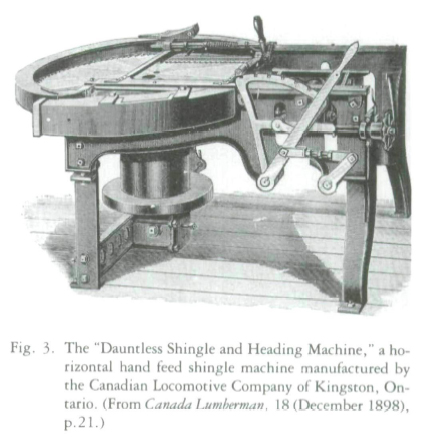 Display large image of Figure 3
Display large image of Figure 3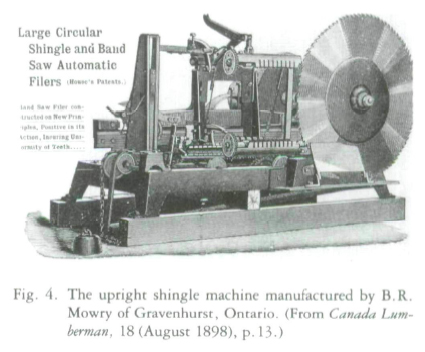 Display large image of Figure 4
Display large image of Figure 413 Frank Johnson's association with the forest industry began at an early age at his father's sawmill in the eastern United States. In 1890 he moved to the Pacific Coast and worked in the shingle industry. In the mid-1890s he moved to British Columbia and became manager of the Dominion Shingle Company's plant in New Westminster. Johnson undertook a study of the shingle machine and decided that one better than the Dunbar could be made. He made extensive revisions to the Dunbar machine and possibly because of this had great difficulty in persuading a machine shop to produce his machine. Finally he was put in touch with Henry Schaake who had opened a shop in New Westminster.15
14 Henry Schaake and Frank Johnson must have seen each other as kindred spirits. Schaake, like Johnson, had been born in the eastern United States. In 1881 Schaake had worked in the fruit canning industry of Baltimore, Maryland, where he learned his trade as a machinist. He had moved to California in 1888 where, being adventurous and having an inventive turn of mind, he incorporated several companies for the production of cans for the then burgeoning fishing industry. The companies used some machinery that Schaake had designed including the "Can Body Soldering Machine" which he patented in California in 1897. Seeing the potential of the growing Fraser River fisheries, he moved to New Westminster. In 1897, in association with the Bell Irving interests who owned the Anglo-British Columbia Packing Company, he managed the Automatic Can Company. When this plant was destroyed along with most of the New Westminster business section in the fire of 1898, Schaake left the Bell Irvings and established his own business. Instead of making cans, he opened a machine shop for the manufacture and repair of machinery mainly related to the fishing industry. Prior to opening his own shop Schaake had permitted the Vulcan Iron Works, also of New Westminster, to manufacture the machinery he had patented. Schaake was probably inspired to open his own shop when John Kellington, an employee at the salmon cannery of Alex Ewen and O.J. Munn, came to him with a "superior" can topping and washing machine. Kellington agreed to turn over the manufacturing rights to Schaake. Thus, when Johnson came to him in 1901 Schaake had been successfully established for nearly two years. The lumber industry was booming and Schaake, with the prior experience of successfully producing and marketing the Kellington machine, must have decided Johnson's machine proposal was an excellent opportunity to expand into another line of machinery.16
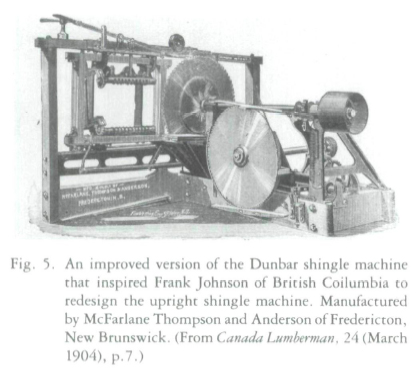 Display large image of Figure 5
Display large image of Figure 5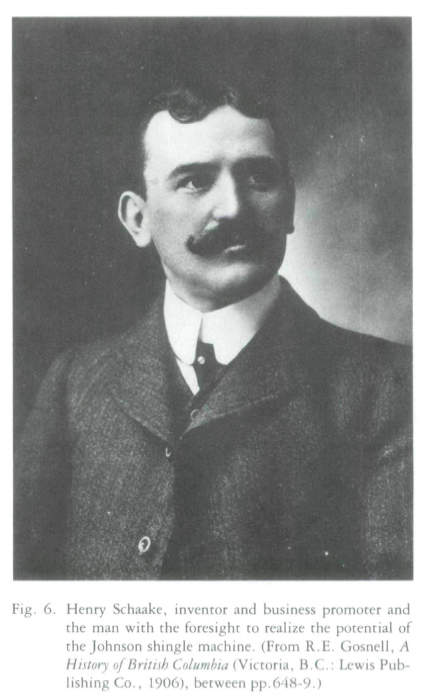 Display large image of Figure 6
Display large image of Figure 615 Over the next two years Johnson and Schaake completely redesigned the Dunbar machine. It is impossible to determine exactly how much input either one had in the final design. The only patent was filed by Johnson in April 1902 and Schaake always referred to the first machines as Johnson machines. However, as the design was developed over a lengthy period, it is likely that Schaake had some input into the first machine.I7
16 The Dunbar machine's most serious fault had been its somewhat erratic drive caused by the use of eccentrics to move the carriage. Johnson changed the eccentric drive to a linked shaft drive on a sliding bearing, thereby providing a much more reliable motion. A similar design is still used today. He substituted wheels for sliding blocks on the carriage and modified the frame and block feed mechanism or setworks. He also substituted an iron frame for the wood frame and a circular saw for the knives which Dunbar had used on the jointer. A detailed examination of the patents reveals that there was very little on the Dunbar machine that was not, to at least a small extent, modified. Thus, except for the basic upright design and the basic motion, the Johnson machine was really a completely new shingle machine, a machine that quickly proved itself to be much more reliable and faster than any other upright then on the market.18
17 Production of the shingle machines began shortly after Johnson approached Schaake. By 1902 the H. H. Spicer Company of New Westminster reported that it was "much pleased" with the "Improved Johnson Shingle Machines" purchased. Not all potential local users accepted the superiority of the new product. In 1902 the Canada Shingle Mill at Hastings (now part of Vancouver) installed twelve new Dunbar machines. Despite this exception the new machine gained acceptance rapidly and it is unlikely that many more Dunbar shingle machines were purchased by British Columbians.19
18 In 1902 and 1903 Schaake still considered his own and other canning machinery for which he held manufacturing rights, such as the Kellington Fish Cleaner, to be his primary products, but the shingle machinery gradually became more important until by 1906 it surpassed canning machinery in sales. Prior to 1906 Schaake had expanded his shops in a rather haphazard fashion, but in that year, with increasing shingle machine production, the decision was made to build an entirely new complex which would be "one of the biggest industries of its kind on the coast."20
19 The new shops included a new foundry, a shop for the production of gasoline engines for small fishing boats, and a separate shop for the construction of shingle and sawmill equipment.21 The separate shop for shingle machinery suggests that by this time Schaake had switched his main production from fish canning equipment to that of forest industry equipment, largely shingle machinery. This step, probably the result of several factors, was primarily due to the great prosperity evident in the forest industry. In contrast, the number of canneries on the Fraser River was declining and Schaake faced heavy comperition in the field of cannery machinery from Letson and Burpee of Vancouver.
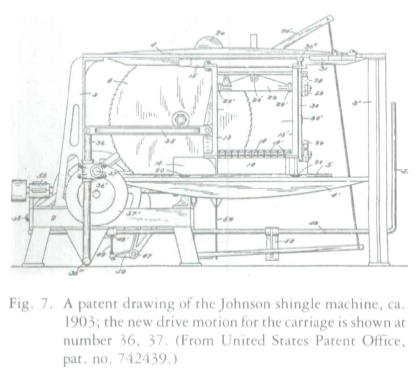 Display large image of Figure 7
Display large image of Figure 7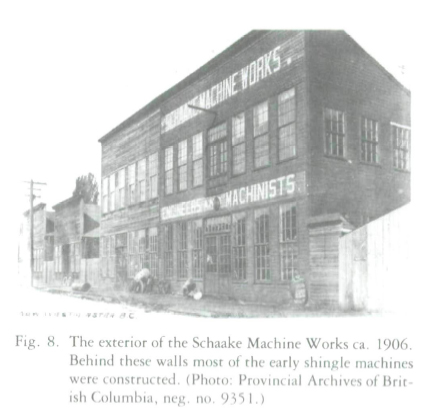 Display large image of Figure 8
Display large image of Figure 820 This same firm also provided Schaake with his main competition in shingle machinery manufacture. The firm was initially established in 1893 when James Letson and Frank Burpee, both former machinists at the British Columbia Iron Works, went into partnership with the intention of producing canning machinery. Initially, the firm was established in New Westminster. However, the greater prospects in rapidly growing Vancouver caused them to move first to Water Street and then to Alexander Street, at the time the major industrial area of the new city.22 Their initiative in both inventing and improving machinery rapidly placed them at the forefront of cannery machinery producers not only in British Columbia but also on the entire west coast, especially after they established a successful branch plant in Fairview, Washington. In 1912 they claimed to have supplied nearly eighty per cent of all cannery machinery used in the province, a substantial business considering that there were approximately eighty canneries in British Columbia in 1912.23
21 The only woodworking machinery produced by Letson and Burpee during the period under study were shingle machines. Frank Burpee filed a patent with the United States patent office less than a year after that filed by Frank Johnson. Production probably began prior to the patents being filed. Burpee's machine, similar to Johnson's, was a complete redesign of existing shingle machines. Whether Burpee based his design on the Dunbar or on the Johnson machine is unclear, but much of the Burpee machine was radically different from either. The most significant feature of the Burpee machine was, like Johnson's, a change in the mechanism used to drive the carriage. Burpee devised a system using a mangle rack, an oblong, inside-toothed gear which engaged and was driven by a smaller gear wheel. Burpee also undertook a major redesign of the carriage and modified the setworks while retaining the wood frame of the Dunbar machine. The design competed very successfully with the Johnson machine and by May 1905 the firm reported that over 250 machines had been sold.24
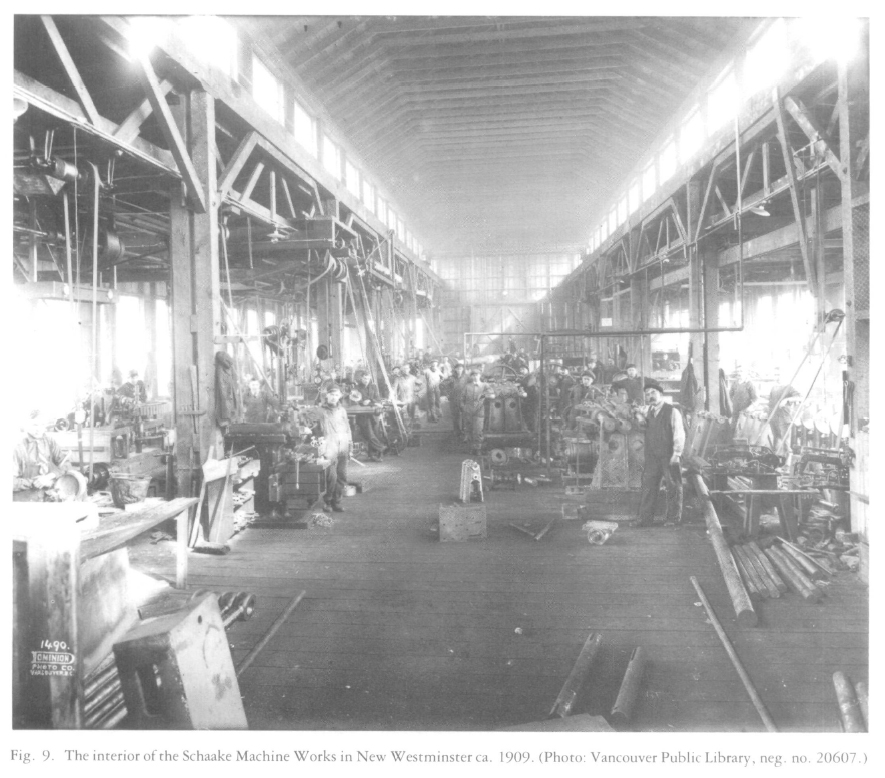 Display large image of Figure 9
Display large image of Figure 922 Schaake continued to improve his machine. The "Johnson-Schaake" shingle machine in 1904 could reportedly cut three more shingles from a block than any other machine on the market. The carriage had been designed to return at great speed for two-thirds of its length and then to slow to prevent jerking and jarring, so that the shingle block moved ahead smoothly, resulting in more uniformly cut shingles. Three heavy bearings supported the saw arbor (the shaft to which the saw was secured) with the driving pulley supported by two bearings. The friction was very "quick and positive which produced instantaneous action." The carriage also had an instantaneous stop motion which reduced the time used by the sawyer when stopping. The jointer saw was improved about 1904, particularly the collars and the receiving table which where redesigned for greater capacity. The machine at this time was capable of producing 20,000 to 30,000 shingles, either 16 or 18 inches in length, per 10-hour shift.25
23 Letson and Burpee did not demonstrate the innovative abilities and interest in shingle machinery evinced by Schaake. In 1905 Burpee redesigned the shingle machine by introducing the simpler steel frame which replaced the wood frame. The Letson and Burpee machine remained basically unchanged until 1910 while Schaake was continually refining his machine.26 Years after the industry came to consider his shingle machine as the "Schaake" machine, he continued to advertise it as the "Johnson Iron Frame Shingle Machine." Nevertheless the improvements were Schaake's. In 1907 he began to cast the frame in one piece instead of bolting it together. This slightly reduced vibration but more importantly it meant that bolts no longer worked loose.27 In February 1909 a one-page advertisement illustrated the major improvements made up to that time. The bed plate was cast in one piece and this included the legs. Many of the parts were made of heavier material to prevent breakage and braces were added front and back. The top rail was oiled by a cup which had to be turned only once a day. The oil flowed down a channel and enabled the carriage to run more smoothly, thereby increasing its life. The set lever was made of cast steel to prevent breakage, the paul (a lever which moved the ratchet that feeds the shingle block ahead) was improved by adding a fixed pressure spring, and the shingle block was held rigid by a double spring. The feed speed on the machine averaged ⅞ of an inch per revolution of the saw, the arbor speed was set at 1,600 revolutions per minute, and 30 shingles could be clipped per minute. The machine weighed 2,800 pounds, occupied a floor space of 7 by 8 feet, and cost $425.00 without the saw.28
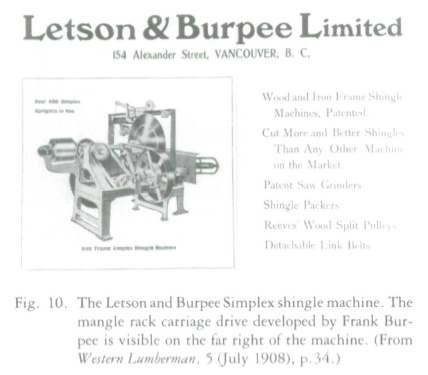 Display large image of Figure 10
Display large image of Figure 1024 In order to compete Letson and Burpee introduced their "Eclipse" machine in 1910. They initially claimed the machine as a radical departure from any other then in use, "giving hitherto unattainable results." The machine, however, was much closer in design to the Schaake machines than their earlier "Simplex" machine. The carriage drive was similar to that used on the Johnson machine while the carriage and setworks were a slightly modified version of the Simplex machine.29 Until 1913 Letson and Burpee offered both machines with either a wood or a cast iron frame though generally the Eclipse appears to have been more popular with an iron frame and the Simplex with a wood frame.30 Surprisingly, the wood frame Simplex machine was the most popular and by 1908 over 400 of them were in use.31 (Despite the popularity ot the Simplex, occasional sales of the Eclipse were made. In 1912, for instance, McMaster and Meghay at Bisson's Siding on the British Columbia Electric Railway installed two Eclipses, and a shingle mill at Webster's Corners in the Eraser Valley purchased one Eclipse.32) The popularity of the Simplex was probably due to its reasonable price and comparative lightness. Letson and Burpee do not appear to have made further innovations until about 1924 when they devised a new and better setworks for their shingle machines.
25 Henry Schaake improved his product to meet the strong competition from Letson and Burpee and looming competition from the United States. Schaake still maintained a slight market edge, perhaps because he was the longest-established supplier and had developed and maintained an excellent reputation for innovation. In July 1908, for instance, Letson and Burpee advertised sales of over 400 machines, while only 6 months later Schaake was able to advertise sales of over 550 machines.33 In 1910 Schaake introduced a wood frame machine to compete with the cheaper Letson and Burpee machines.34 In 1913 he modified his shingle machine by placing a solid gear wheel on the Johnson motion, by changing the bracing in the top carriage runner, and by installing an additional brace on the frame near the carriage drive gearing.35 By 1914 the machine included a double butting attachment and grainer.36 After this changes ceased for several years, probably as a result of the sale of the firm to Heaps Engineering in 1912 and of a changing economic structure after the First World War.
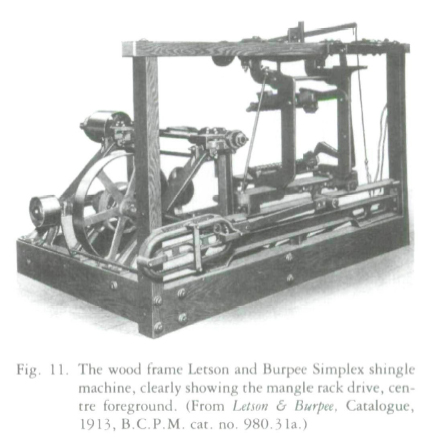 Display large image of Figure 11
Display large image of Figure 11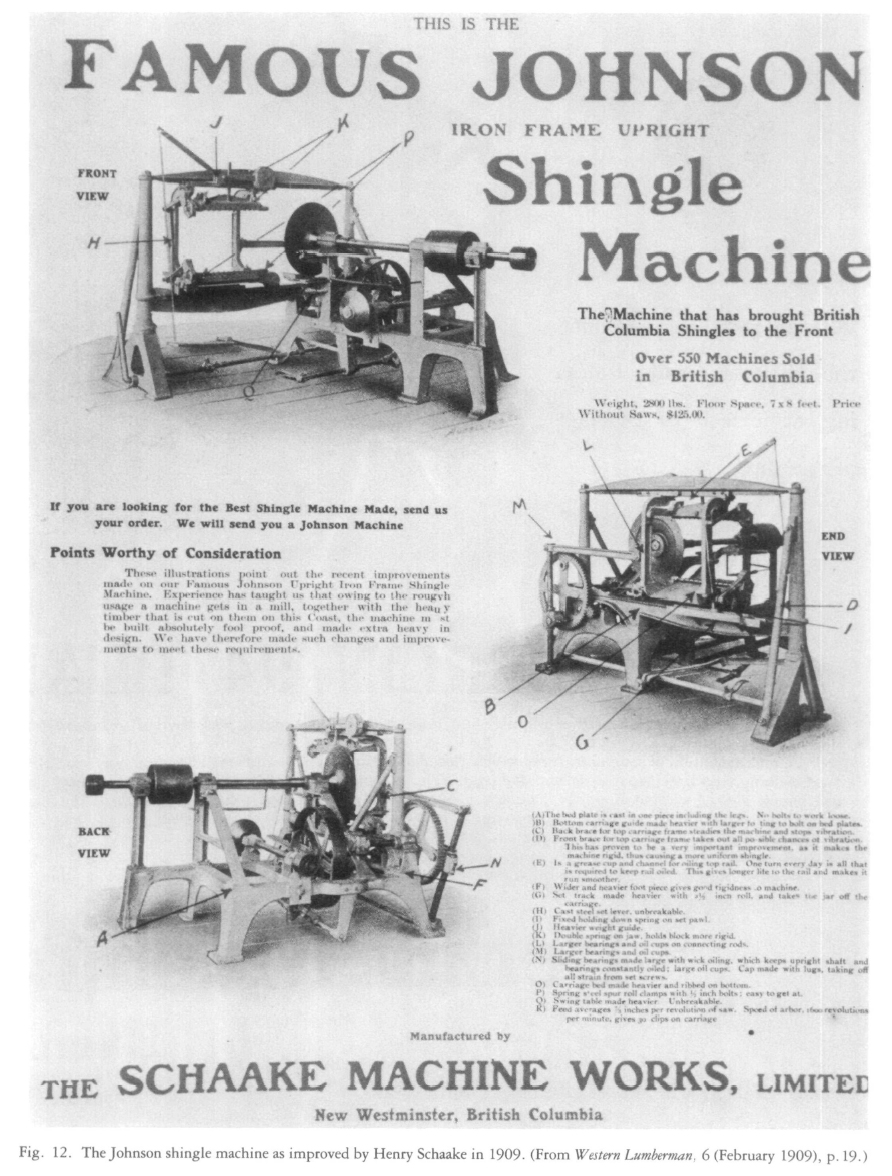 Display large image of Figure 12
Display large image of Figure 12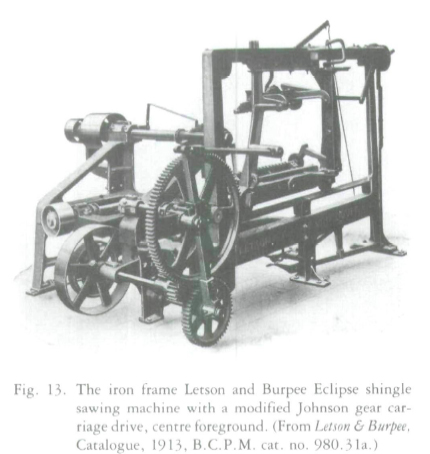 Display large image of Figure 13
Display large image of Figure 1326 In this period increasing competition came from the United States. The first and most important of the new upright machines was produced by Sumner Iron Works of Bellingham, Washington, about 1905. The Sumner machine had numerous changes and modifications, which made it acceptable as an invention to the Canadian Patent Office, but in many respects it was still a modified Johnson machine. The carriage and the carriage drive were changed slightly but functioned on the "Johnson" principle. What was new and important was the mechanism used to advance the block after each cut. The Sumner Iron Works setworks was operated by a bell crank lever mounted on the front of the carriage. The bold crank was activated by wheels on the carriage which engaged sloping arms on the frame. In contrast the Johnson setworks consisted of a vibrating lever and a wheel in a channel while the Letson and Burpee setworks used a lever and cam motion; neither was nearly as satisfactory as the Sumner setworks.37 The Sumner machines provided serious competition for the Canadian manufacturers, especially after 1909 when Canadian Sumner Iron Works was incorporated to manufacture and sell the machines in Canada.
27 The newcomers, Heaps Engineering, believed themselves to be capable of meeting this competition. Edward H. Heaps had arrived in Vancouver in 1888 from Manchester, England, where he had been engaged in cotton manufacturing for eleven years. In Vancouver he began business with the purchase of two shingle machines. His interests grew until he owned a large sawmill and shingle mill in Vancouver and another mill at Ruskin in the Fraser Valley. He also dealt in new and used machinery and maintained a small machine shop at his Vancouver sawmill.38 In 1911 a decision was made to incorporate Heaps Engineering, initially to represent several English diesel and semi-diesel firms.39 The Ruskin Sawmill, however, had been destroyed by fire in 1910 and the family decided to rebuild on a larger scale.40
28 It was probably the destruction of the Ruskin mill which led to Heaps's acquisition of the Schaake Machine Works which by this time had established a reputation for sawmill machinery as well as shingle machinery. The acquisition cost approximately $150,000. Henry Schaake remained as manager while Edward Heaps's son became superintendent.41
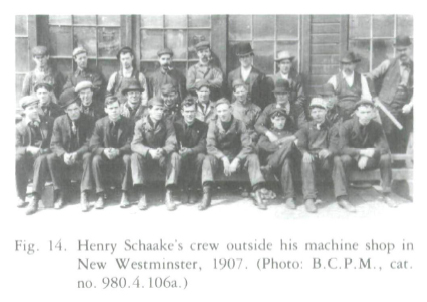 Display large image of Figure 14
Display large image of Figure 14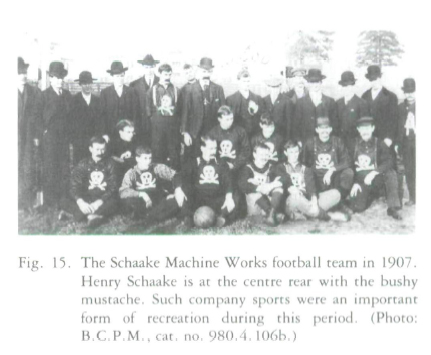 Display large image of Figure 15
Display large image of Figure 1529 Heaps Engineering immediately undertook two major projects which seriously taxed the firm's resources. The first was that of supplying the equipment and rebuilding the Ruskin sawmill at an estimated cost of 2 million dollars. In addition, the firm moved its operation to Lulu Island, south of Vancouver, where huge facilities were constructed in 1912. The machine shop was 90 by 400 feet, the foundry 80 by 280 feet, a pattern and storage facility was 60 by 200 feet, and an additional warehouse was constructed measuring 50 by 200 feet. The machine shop alone was 36,000 square feet larger than the total facilities Schaake had previously occupied — about 32,200 square feet. In contrast, the Letson and Burpee machine shop of 1915 was only about 12,000 square feet. Heaps initially intended to employ 250 men in the plant and an additional 150 men in a separate diesel facility.42
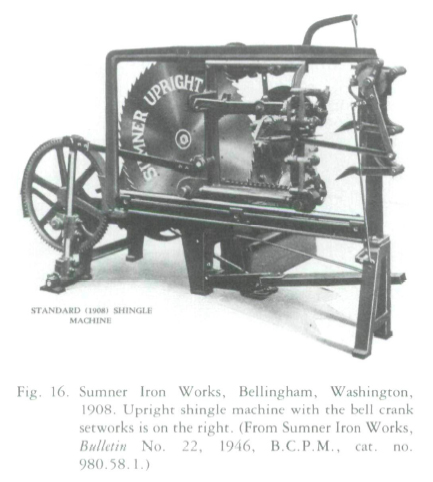 Display large image of Figure 16
Display large image of Figure 16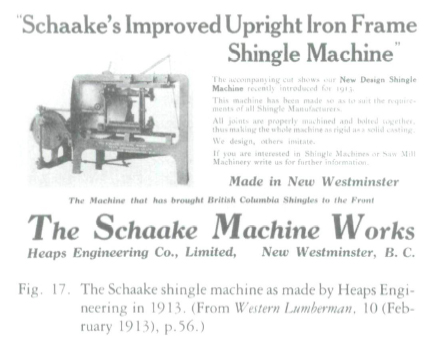 Display large image of Figure 17
Display large image of Figure 1730 However, while the company was immediately busy, British Columbia was never able to provide sufficient business to support such a large facility, particularly when a number of highly reputable firms such as Vulcan Iron Works, also of New Westminster, were competing for business. Even gaining such major contracts as the construction of the Hunting-Merritt shingle mill in 1914 could not offset the problem of too large a facility. In 1915 the company was only employing 30 men, in serious financial difficulty, and facing liquidation.43 It was only because or the urgent need for munitions for the First World War that an agreement was reached with creditors which permitted the company to carry on.44 The munitions contracts gave Heaps Engineering the breathing space necessary for survival but left little opportunity for studying and implementing improvements in shingle machines.45 Also, the financial difficulties facing Heaps and the availability of war munitions contracts provided Henry Schaake with an option of re-establishing himself as an independent manufacture.46
31 Initially Schaake re-established his business in New Westminster in 1915 but in 1917 decided to move his facilities to the newly opened industrial development on Granville Island in Vancouver.47 Shortly after opening his business Schaake designed and produced a new shingle machine. The new "Acme" did not go into full production until the end of the war and the completion of the munitions contracts, though six machines were made and installed for the new West Vancouver shingle mill of the Dominion Cedar and Shingle Company in 1917.48
32 The Acme was a definite improvement over the old Johnson machine. Schaake lightened it from 4,000 to 3,000 pounds. He incorporated a version of the bell crank and wheel setworks that had first been used on the Summner Iron Works machines and he also included a double butter and grainer attachment with the machine.49 Despite good reports and Schaake's well known reputation as a "clever inventor and a master mechanic," the firm did not survive long.50 In 1920 or 1921 he went broke, possibly due to over-extension resulting from the development of a new tractor design.51 The Acme shingle machine never made an impact on the market. Schaake's plant was taken over by the British Columbia Steel Works but without success, possibly due to the intensified competition which developed shortly after the end of the war.
33 Shingle producers in the United States gradually realized the necessity of convening at least part of their production from the horizontal to the upright shingle sawing machine in order to compete with the better quality British Columbia shingles. This resulted in an expansion of American production of the upright machines. The Sumner Iron Works machine was the first to compete with the Letson and Burpee plant at Fairview, Washington, and with a short-lived plant established by Schaake at Seattle, Washington. The Union Machinery Depot of Seattle, the Puget Sound Machinery Depot of Tacoma, Washington, which by 1913 was maintaining a Canadian sales office, and the Challoner Company of Oshkosh, Wisconsin, which produced an upright machine by about 1912, all copied the Johnson machine. Gradually some of these manufacturers were able to expand into Canada.52
34 While it is uncertain whether the Union Machinery Company, the Star Machinery Company, (a major Seattle machinery distributor), or the Challoner Company ever sold machines in British Columbia, the Puget Sound Machinery Company did sell them to the Weeks-Dunnell Lumber Company at Fanny Bay on Vancouver Island and the Sumner Iron Works remained very successful even after it closed its British Columbia operation in January 1914.53 In 1915 Sumner sold to the J.N. Sutton mill at Arrowhead and to Shull Lumber and Shingle Company on the Fraser River54 and in 1917 to Brunette in New Westminster and to the Kootenay Shingle Company at Salmo.55 In 1917 Sumner Iron Works also made a major sale often of the very durable and successful "Gold Medal" uprights to the Whalen Pulp and Paper Company at Quatsino Sound on Vancouver Island.56
35 The emphasis by Canadian manufacturers on the war effort, especially before 1917, provided an opportunity for American firms, Sumner Iron Works in particular, to firmly establish themselves in the British Columbia market. Sumner Iron Works, in fact, was so firmly entrenched in the British Columbia market that it re-established a branch plant there. In 1919 Sumner entered into an agreement with Allan and McKelvie of Vancouver, a small marine engineering firm which changed its name to Canadian Sumner Iron Works Limited. The new firm undertook the manufacture of the lumber machinery that the Sumner Iron Works manufactured under patent, eventually securing a large share of the British Columbia market for sawmill and shingle machinery.57
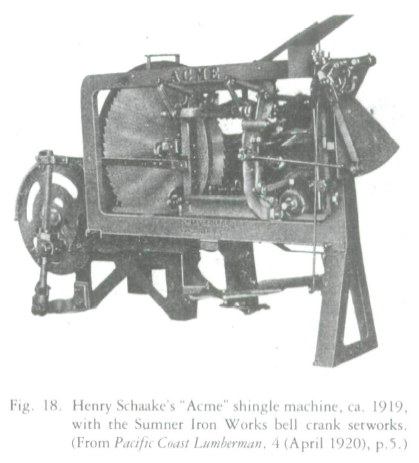 Display large image of Figure 18
Display large image of Figure 18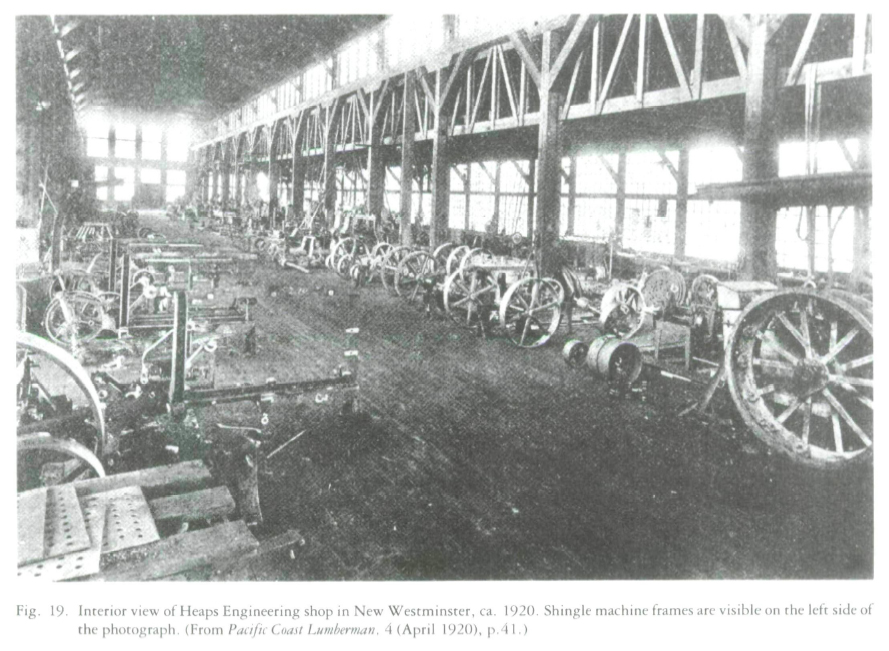 Display large image of Figure 19
Display large image of Figure 1936 The close of the war not only increased American competition but also provided an opportunity for increased competition among British Columbia firms. Heaps Engineering emerged from the war recovered from its financial difficulties and immediately redesigned its machinery line. One of the first items to receive attention was a new shingle machine. The patentable part of the new machine was a version of the bell crank and wheel setworks introduced by Sumner Iron Works and also adapted by Schaake for his ill-fated Acme machine. Heaps and E.T. McDonald, "his expert," also added a new style of spault catcher, a simplified clutch system, and a carriage designed to swing out to permit easier access to the saws. The "Cedar King" was said to meet the demands of the industry for a "real shingle machine," one that was superior to "anything yet produced one that [would] stand up to the hard work, cost less for repairs [and] be easier to operate." The machine was based on the ideas of others. Even the new system on the carriage "to take up wear and to eliminate side play automatically" was based on Schaake's machine, but the combined elements led the Pacific Coast Lumberman to conclude that the Cedar King was in a "class by itself.58
37 The last immediate postwar change was the addition of a new Canadian manufacturer of shingle machines. Webb and Gifford, also of New Westminster, were very familiar with the Johnson product and manufactured machines similar to it. Herbert B. Webb had been a foreman for Schaake while James Gifford apprenticed at the Schaake shop. In 1911 they formed a partnership and opened a small machine shop, prepared to undertake sawmill or other repairs. In 1915 they completed a design for a shingle machine but as with other British Columbia shops the priority for munitions contracts delayed production until 1919 when a modified version of the "Ideal" shingle machine appeared. The machine had a solid cast iron frame because the base called for in the 1915 design60 had been too light. The carriage was steel and thus about half the weight of the standard cast iron carriage then in use. The machine ran on V-shaped rollers which permitted very smooth travel; the setworks were the "old reliable Ideal setworks," a number of which Webb and Gifford were making for sale to shingle mills for use on other manufacturers' machines. The setworks was similar to the earlier designs with bell crank, roller, and arm. Another significant development introduced by Webb and Gifford was the "Perfect Ratchet. " The ratchet was attached to the bell crank of the setworks and permitted very precise feed of the shingle block. This ratchet was so good that in many instances shingle mills converted existing machines to the Webb and Gifford ratchet.61 Their small shop, having only six lathes in 1922, had introduced several important changes: heavier solid cast iron frame machines, steel parts, the use of the "Ideal" setworks, and the "Perfect Ratchet."62
38 In 1924 or 1925 Letson and Burpee developed a new setworks that was not based on the bell crank, roller, and arm concept of the earlier shingle machines. Instead, the arms over which the rollers ran were separated from the end frame of the machine; the rollers were also set diagonally instead of horizontally. The motion was imparted to the spur roll on which the shingle block rested by a friction clutch instead of a ratchet, and shingle thickness was set by adjusting screws which were much easier to use than any previous system.63
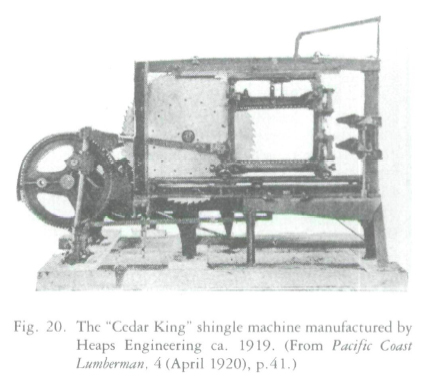 Display large image of Figure 20
Display large image of Figure 20 Display large image of Figure 21
Display large image of Figure 21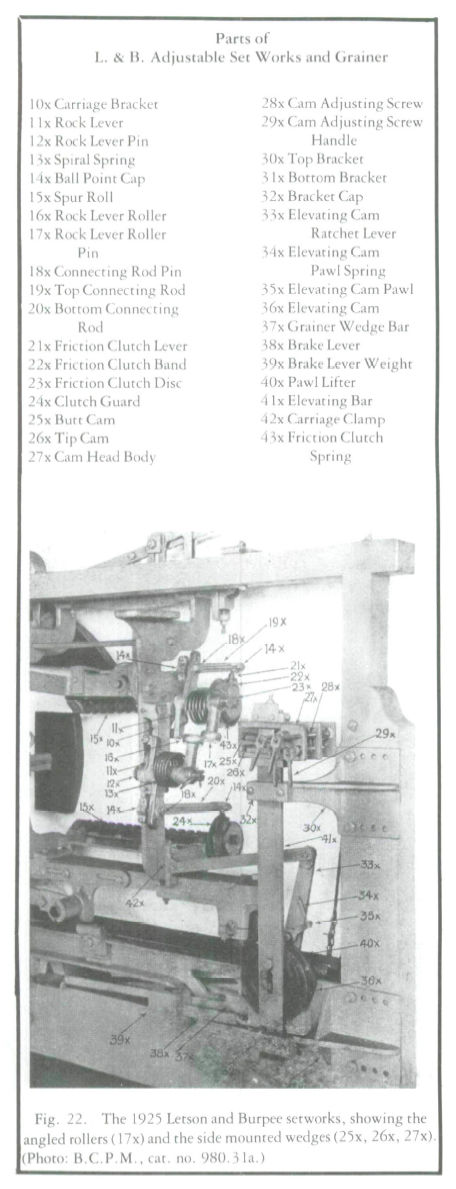 Display large image of Figure 22
Display large image of Figure 22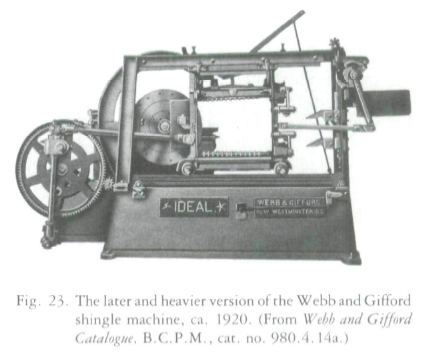 Display large image of Figure 23
Display large image of Figure 2339 Improvements following the Letson and Burpee set-works were less significant and less rapid than those that had occurred throughout the previous twenty-four years. The economic impact of manufacturing the machines also diminished during the next decades until Webb and Gifford, acquired by Brunette Machine Works, was the only remaining producer of shingle sawing machines in British Columbia. Brunette took over the machine designs of the other producers and incorporated the best components of these into the Webb and Gifford shingle machine.
40 The manufacture of shingle machinery was an important industry in British Columbia. It was this machinery that enabled several machine shops to eventually become major British Columbia manufacturers. The growth of the Schaake Machine Works can be directly attributed to the successful production of shingle machinery. This production also led the shop into production of a wide variety of other shingle and sawmill machinery, especially after the firm was taken over by Heaps Engineering in 1912. Letson and Burpee's prior experience with shingle machinery permitted a smooth transfer of its main production from cannery machinery to sawmill machinery during the 1950s when demand for the cannery machinery was declining and the American Can Company began to dominate this trade.
41 It took roughly two weeks for three men to produce a shingle machine; this multiplied many times meant an extensive business in manufacturing shingle machines.64 The extent of this production can be seen in a list of sales of Letson and Burpee machines published in the December 1916 Western Lumberman:
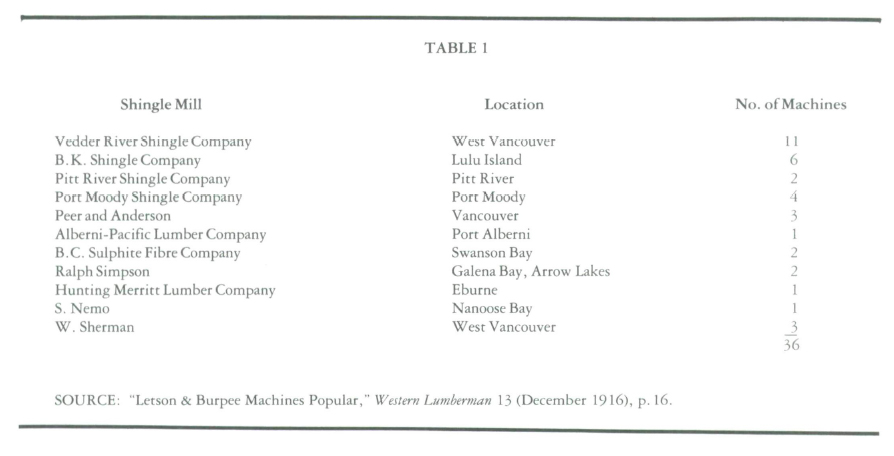 Display large image of Table 1
Display large image of Table 1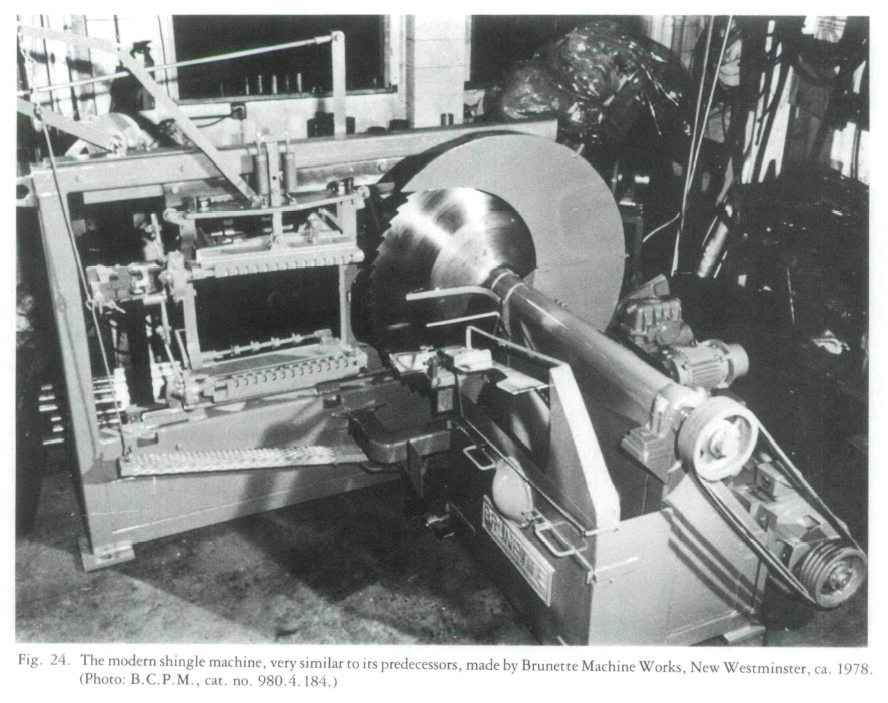 Display large image of Figure 24
Display large image of Figure 2442 This is not a complete list and only gives the number of machines purchased, not necessarily the total number of machines in the plant. Based on the above criteria this yields approximately 216 man-weeks of work. The extent of the business of shingle machine production was also indicated in 1909, at which time the company had sold 572 machines at an advertised price of $425.00 each. This represents sales of over $240,000 for approximately 8 years — a considerable sum of money.65 Shingle machinery thus represented an important aspect of British Columbia manufacturing.
43 Surprisingly little of the incentive for development, aside from the first step by Frank Johnson, appears to have been the result of shingle mill operators, but rather resulted from the efforts of the shops to improve the machine. Presumably the rapidity with which the advances were made was partially a result of the strong competition that existed. Despite such advances, however, the differences between production on various machines were slight and frequently a single mill would have several makes. In 1913 Irwin Shingle Company of New Westminster had four Schaake machines, four Letson and Burpee machines, and one Sumner Iron Works machine.66
44 The production of these machines also demonstrates that not all technology was imported into the province. Significant development in the shingle sawing machine was undertaken by mechanics in British Columbia. In 1907 Henry Schaake brought this to everyone's attention, "Once more we improve We have constantly added original improvements, which others have tried to follow but the strides are too rapid."67 The bulk of the modifications represent seemingly minor changes, but in sum the capability and use of the shingle sawing machine were significantly changed in British Columbia. The British Columbia innovations brought a manufacturing industry to the province and also resulted in feedback to eastern manufacturers. As a result of these machines the whole style of shingle cutting was changed from the mass production horizontal machine to the less productive but better quality upright machine. The following comparison shows the large difference in available production and indicates the dramatic quality improvement of the upright machine.
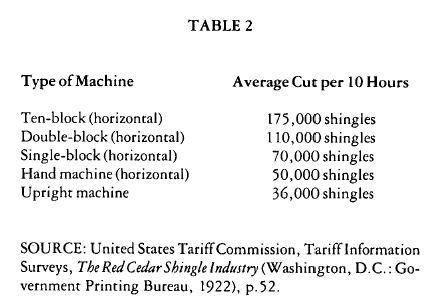 Display large image of Table 2
Display large image of Table 245 This quality improvement of shingles is directly related to the technical innovations of British Columbians.